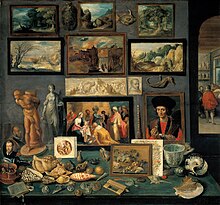
Back Wunderkammer ALS حجرة العجائب Arabic Gabinet de curiositats Catalan Kabinet kuriozit Czech Raritetskabinet Danish Wunderkammer German Kuriozaĵkabineto Esperanto Cuartos de maravillas Spanish Bitxikerien kabinetea Basque Kuriositeettikabinetti Finnish


Cabinets of curiosities (German: Kunstkammer and Kunstkabinett), also known as wonder-rooms (German: Wunderkammer), were encyclopedic collections of objects whose categorical boundaries were, in Renaissance Europe, yet to be defined. Although more rudimentary collections had preceded them, the classic cabinets of curiosities emerged in the sixteenth century. The term cabinet originally described a room rather than a piece of furniture. Modern terminology would categorize the objects included as belonging to natural history (sometimes faked), geology, ethnography, archaeology, religious or historical relics, works of art (including cabinet paintings), and antiquities. In addition to the most famous and best documented cabinets of rulers and aristocrats, members of the merchant class and early practitioners of science in Europe formed collections that were precursors to museums.

Cabinets of curiosities served not only as collections to reflect the particular curiosities of their curators but also as social devices to establish and uphold rank in society. There are said to be two main types of cabinets. As R. J. W. Evans notes, there could be "the princely cabinet, serving a largely representational function, and dominated by aesthetic concerns and a marked predilection for the exotic," or the less grandiose, "the more modest collection of the humanist scholar or virtuoso, which served more practical and scientific purposes." Evans goes on to explain that "no clear distinction existed between the two categories: all collecting was marked by curiosity, shading into credulity, and by some sort of universal underlying design".[1]
In addition to cabinets of curiosity serving as an establisher of socioeconomic status for its curator, these cabinets served as entertainment, as particularly illustrated by the proceedings of the Royal Society, whose early meetings were often a sort of open floor to any Fellow to exhibit the findings his curiosities led him to. However purely educational or investigative these exhibitions may sound, it is important to note that the Fellows in this period supported the idea of "learned entertainment,"[2] or the alignment of learning with entertainment. This was not unusual, as the Royal Society had an earlier history of a love of the marvellous. This love was often exploited by eighteenth-century natural philosophers to secure the attention of their audience during their exhibitions.
- ^ Impey, MacGregor, Oliver, Arthur. The Origins of Museums: The Cabinet of Curiosities in Sixteenth- and Seventeenth-Century Europe. Oxford University Press. p. 737.
{{cite book}}: CS1 maint: multiple names: authors list (link) - ^ Fontes da Costa, Palmira. "Singular and the Making of Knowledge at the Royal Society of London in the Eighteenth Century". Cambridge Scholars Publishing. Retrieved 9 December 2014.
© MMXXIII Rich X Search. We shall prevail. All rights reserved. Rich X Search